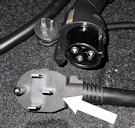Just Plug it In? Charging an electric car or electric vehicle (EV) might well seem mysterious to the uninitiated, so we’ve set out here to simplify the charging process. Just like charging your smartphone, at first blush the car just needs to be plugged in. There are three levels of charging that, in effect, move …
Tag: CHAdeMO
Permanent link to this article: https://dashboardsymbols.com/2023/12/charging-an-electric-car-the-basics-you-need-to-get-started/

